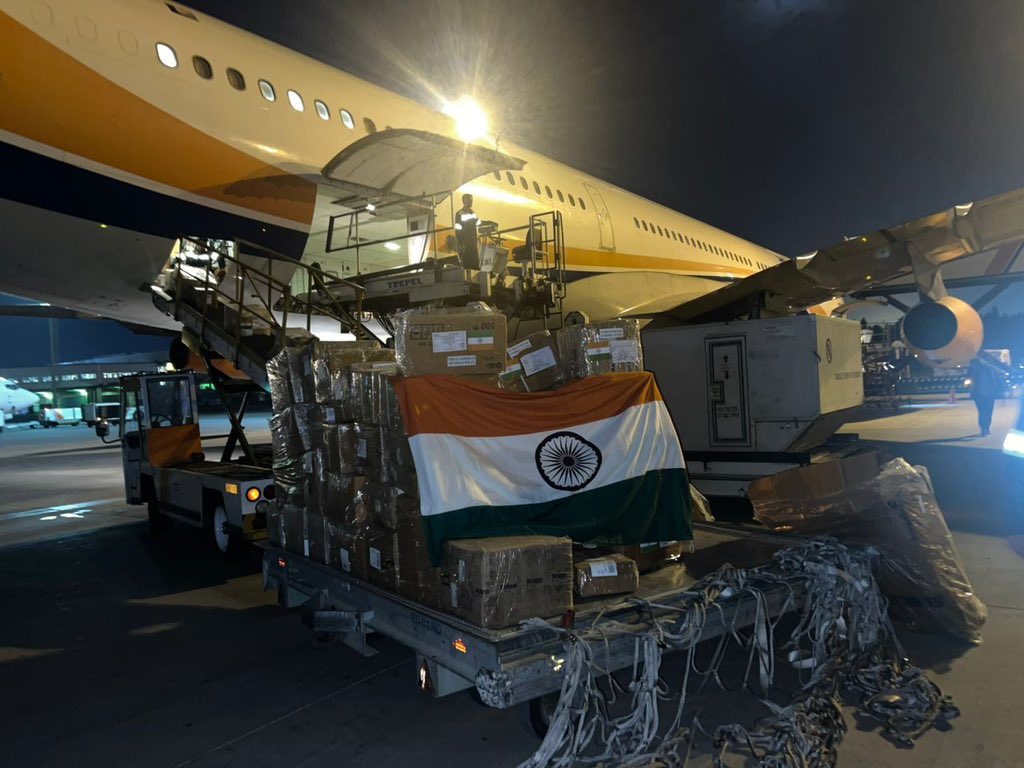India’s Humanitarian Assistance and Disaster Relief (HADR) & Soft Diplomacy

- 09 Sep 2025
Introduction
Humanitarian Assistance and Disaster Relief (HADR) has emerged as a cornerstone of India’s foreign policy and regional engagement. Rooted in the ethos of “VasudhaivaKutumbakam” (the world is one family), India has actively extended aid during natural disasters, reflecting both compassion and strategic foresight. The recent dispatch of 21 tonnes of relief material to Afghanistan after the devastating 6.0-magnitude earthquake, which killed over 1,400 people, underlines India’s commitment to humanitarian outreach and its role as a responsible global actor.
Understanding HADR and Soft Diplomacy
- HADR refers to India’s coordinated relief and rescue operations in disaster-hit regions, at home and abroad. It includes the supply of food, medicines, shelter, sanitation, and technical support.
- Soft Diplomacy implies the use of non-coercive instruments—humanitarian aid, cultural goodwill, and capacity-building initiatives—to enhance India’s global influence and strengthen bilateral trust.
Together, HADR and soft diplomacy enable India to project power through empathy rather than force.
Key Features of India’s HADR Approach
- Rapid Response: The Indian Air Force and Navy ensure swift deployment of relief materials and evacuation missions. For instance, the IAF’s strategic airlift capabilities enable timely supply drops in inaccessible regions.
- Inclusive Relief: Aid packages typically include medicines, food, water, tents, blankets, and water purifiers, focusing on essential survival needs.
- Neutral Assistance: India provides aid without attaching political preconditions, strengthening credibility and neutrality.
- Global Footprint: Beyond neighbours, India has extended assistance to Africa, Pacific Island states, and West Asia, thereby widening its humanitarian outreach.
- Institutional Mechanisms: Agencies like NDMA, NDRF, IAF, Indian Navy, and the Ministry of External Affairs ensure coordination for effective large-scale responses.
Strategic Importance of HADR
- Regional Goodwill: India has earned the reputation of being the “first responder” in South Asia and the Indian Ocean Region. Operations during the Nepal earthquake (2015), Sri Lanka floods, and Maldives water crisis (2014) highlight this proactive role.
- Trust-Building: Humanitarian gestures strengthen bilateral ties, particularly with vulnerable neighbours such as Afghanistan, Nepal, Sri Lanka, and the Maldives.
- Soft Power Projection: Such assistance reinforces India’s image as a responsible rising power committed to collective security and humanitarian values.
- Security Dimension: Active engagement through HADR enhances maritime security partnerships and counters external influences in the region, particularly China’s growing footprint in the Indian Ocean.
Contemporary Relevance
In a world marked by climate change, extreme weather events, and fragile states, the frequency of humanitarian crises is increasing. India’s HADR capacity demonstrates both moral leadership and strategic autonomy. For example, during the COVID-19 pandemic, India’s “Vaccine Maitri” initiative delivered vaccines to over 90 countries, merging humanitarianism with diplomacy.
Furthermore, India’s active participation in multilateral frameworks like BIMSTEC, IORA, and QUAD’s disaster response initiatives showcases its evolving role in shaping global disaster governance.
Challenges
- Logistical hurdles in conflict zones like Afghanistan.
- Resource constraints given India’s vast domestic vulnerabilities.
- The need for greater coordination between civilian and defence agencies.
Conclusion
India’s HADR efforts, anchored in soft diplomacy, reflect a balance of humanitarian compassion and strategic pragmatism. By acting as a credible first responder, India not only saves lives but also nurtures trust, stability, and regional cooperation. In the long run, strengthening institutional mechanisms, enhancing maritime capacity, and integrating climate resilience will further consolidate India’s role as a humanitarian power in a volatile world.
Suposhit Gram Panchayat Abhiyan

- 26 Dec 2024
In News:
On December 26, 2024, Prime Minister Narendra Modi presided over the Veer Bal Diwas celebrations at the Bharat Mandap in New Delhi. This annual event commemorates the martyrdom of the sons of Sri Guru Gobind Singh Ji and highlights the importance of nurturing the next generation. During the occasion, PM Modi also launched the ‘Suposhit Gram Panchayat Abhiyan,’ an initiative aimed at improving nutrition and well-being in rural India.
Veer Bal Diwas: Commemorating Sacrifice and Courage
Veer Bal Diwas was declared on January 9, 2022, by PM Modi to honor the sacrifices made by the young sons of Guru Gobind Singh Ji — Sahibzada Baba Zorawar Singh and Baba Fateh Singh — who were martyred in 1704. During the Mughal-Sikh battles, these two brave boys were captured and offered safety if they converted to Islam, which they refused. Their refusal to abandon their faith led to their brutal martyrdom by being bricked alive in the walls of a fort in Sirhind (Punjab). This act of resilience and unwavering faith is a cornerstone of Sikh history and culture.
Veer Bal Diwas not only commemorates their sacrifice but also serves as a reminder of the strength, faith, and courage demonstrated by all four of Guru Gobind Singh Ji’s sons. It underscores the Sikh ideals of sacrifice, courage, and dedication to faith.
Suposhit Gram Panchayat Abhiyan: Addressing Malnutrition in Rural Areas
On the same day, PM Modi launched the 'Suposhit Gram Panchayat Abhiyan', a nationwide mission focused on improving nutritional outcomes in rural areas. The initiative aims to enhance nutrition-related infrastructure and promote active community participation in tackling malnutrition. By encouraging village-level involvement, the program seeks to ensure that nutrition becomes a community-driven effort.
Key Objectives
- Malnutrition Eradication: The initiative focuses on combating malnutrition in rural communities by improving access to better nutrition.
- Healthy Competition: Encourages competition among villages to adopt best practices for nutrition and overall health.
- Sustainable Development: Promotes long-term, sustainable health practices that align with India's broader goals, such as the Poshan Abhiyan and the Sustainable Development Goals (SDGs).
The program aims to make rural populations active participants in improving their own well-being, strengthening community-driven initiatives for better nutritional outcomes.
Engaging Children and Fostering Patriotism
In line with Veer Bal Diwas, various events were organized to engage young minds across the nation. These initiatives not only raised awareness about the significance of the day but also fostered a culture of courage, dedication, and patriotism.
- Online Competitions: Interactive quizzes were conducted through platforms like MyGov and MyBharat to encourage participation and understanding of Veer Bal Diwas.
- Creative Activities: Schools, Child Care Institutions, and Anganwadi centers organized storytelling, creative writing, and poster-making contests to engage children and promote nationalistic values.
Honoring Young Achievers: PMRBP Awardees
The event also saw the presence of the recipients of the Pradhan Mantri Rashtriya Bal Puraskar (PMRBP), which recognizes children who have demonstrated exceptional abilities in various fields. The awardees, 17 in total, were presented with medals, certificates, and citation booklets by President Droupadi Murmu. These young achievers served as a source of inspiration, reinforcing the theme of celebrating youth potential on Veer Bal Diwas.
Conclusion: Strengthening the Foundation of India’s Future
The celebrations of Veer Bal Diwas and the launch of the Suposhit Gram Panchayat Abhiyan highlight the government’s commitment to nurturing India’s future by investing in its children and rural communities. By honoring historical sacrifices and fostering community-driven health and nutrition initiatives, these efforts contribute to building a resilient, prosperous India that can meet global challenges head-on. The twin focus on children’s development and rural well-being underscores India’s vision of a healthier, more inclusive society, aligned with national and global development goals.
